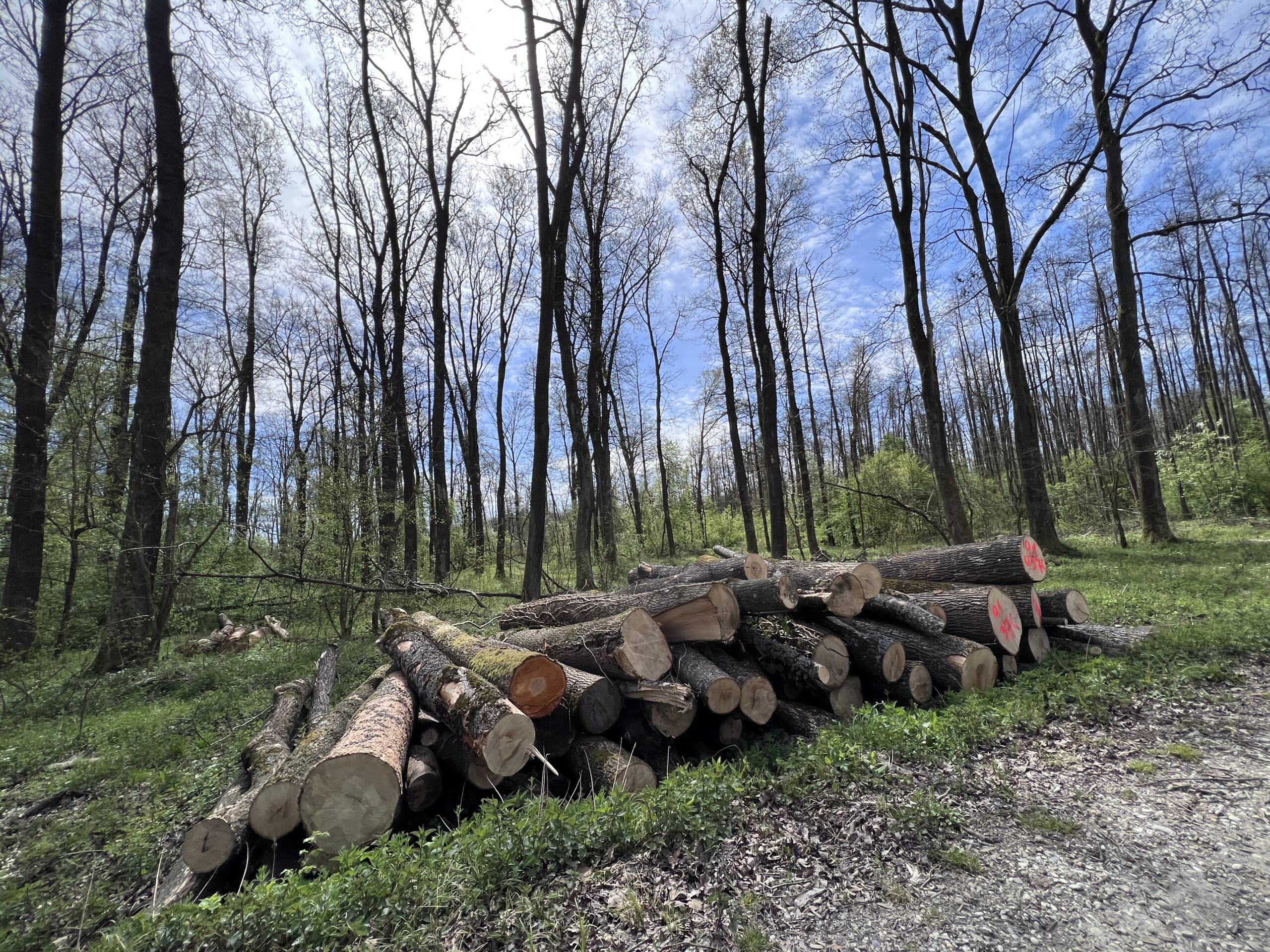Forestry is an exciting investment opportunity that’s growing in popularity in the United States. Investors are exploring new ways to invest their money as inflation increases and economic uncertainty grows. Safe investments are almost impossible, but investments with less risk can be the key to inflation-proofing our assets. Real estate has stood the test of time as a safer investment, and forestry offers more than just unrealized gains. If you are thinking of where to park your money for the future and want some realized gains sooner than later, forestry might be the right investment for you. In this blog post, I’ll walk you through the steps of harvesting your forest in the USA, including a harvest plan, discussing mills and consultants, selecting the right harvesting companies, finding markets for your logs, and ensuring a smooth transition to planting your next crop.
When it’s time to harvest, you can work directly with a logger, a forestry consultant, or a registered forester. All these options would tell you what to expect, and they would contact a few mills for assessments. Professional forestry investors do not recommend working directly with a mill because they will pay the least. Be cautious of flipping, where someone will come and get you to agree on a contract, then sell it to a mill, and then flip it for a higher price, making the profit and leaving you out of the deal. It would be best if you were the one getting the direct payments. One of the amazing things about forestry investing is that when it’s time to harvest, you aren’t in a hurry; you can take your time to learn what you need to know before cutting down trees.
The Characters:
You:
An investor, family landowner, or farmer, maybe you inherited some land. If your knowledge is lacking in forestry harvesting, consider including a professional who can advocate your side of the deal. Learn what you need to know before embarking on this journey because there will always be challenges, and you need to know how to handle them.
Consultants:
Consultants should take 5-10%; that’s reasonable; anything more is too much. When it comes to harvesting your forest, it’s crucial to collaborate with reputable and experienced harvesting companies. These companies specialize in safely and efficiently felling, transporting, and processing trees for various uses. Look for companies with a proven track record, positive customer reviews, and adherence to sustainable forestry practices.
Contact a consultant, discuss what sort of wood you have and what you can expect from working with them, and ask them about their process. Try really hard not to make any commitments to them quickly, research first. Make sure they aren’t taking more than 10% for their efforts. They are supposed to help you with this process; that’s why they get paid for the transaction. Ask as many questions as you need in advance. Make sure you have a good feeling for them before signing a contract.
Wholesalers:
Organizations that make deals by flipping the contract for a better rate without you. Be careful of wholesalers that will create a contract, get you to agree, and then they will sell that contract. They won’t manage the land or help you because they are in it for a quick buck. Mills and loggers can also flip contracts, which means less than satisfactory experiences for you and your land as they will make the purchase under what the logs are valued at. Remember that you want to sell the wood but also want someone who will harvest sustainably, making your next crop healthy. Be careful when selecting who to work with.
Saw Mills:
Mills do the work of processing the wood; they would prefer the best price possible. If you want your best price, you need someone to work with you and the mills on a mutually beneficial contract. Sawmills process logs into lumber for various construction and woodworking applications. Look for local or regional sawmills interested in the type of wood you’ve harvested. Consider selling to pulp and paper mills if your forest contains softer wood varieties. These mills use wood fiber to produce paper products. Some wood types might be suitable for bioenergy production. Biomass facilities use wood waste to generate renewable energy.
Outsourcing
When outsourcing harvesting services, it’s crucial to research and vet potential companies thoroughly. Look for those with a history of sustainable practices, positive customer reviews, and a commitment to safety and environmental stewardship. Consult with other landowners, forestry professionals, or industry associations and ask for recommendations and insights about reliable harvesting partners. Additionally, consider each company’s specific services, geographic coverage, and how well they align with your investment goals and values. Make sure to choose a company that will cut in an environmentally sustainable way. I’ve heard stories of people having the trees cut in horrible ways, making the land a mess, and doing a ton of extra work to get the next crop planted.
Some well-known Outsourcing harvesting companies in the USA include:
Weyerhaeuser: is a leading sustainably focused timberland owner and manager with experience in sustainable forest management and harvesting.
Rayonier: is known for its expertise in timberland management and sustainable harvesting practices.
PotlatchDeltic: is a company that focuses on responsible forest management and timber sales.
Green Diamond Resource Company: offers forest management and sustainable harvesting services, focusing on balancing economic and environmental goals.
Plum Creek Timber Company: is known for its timberland management expertise, and it offers various forestry services, including harvesting, land management, and consulting.
Forest Resource Consultants: provide comprehensive forest management services, including timber sales, reforestation, and inventory management.
Timberland Harvesters, LLC: specializes in timber harvesting, land clearing, and forest management services, catering to private landowners and timber investors.
Timberland Investment Resources: offers various forestry services, including timber sales, appraisals, and forest management, tailored to individual investor needs.
F&W Forestry Services: focuses on sustainable forestry practices; they offer various services, including timber sales, land management, and investment analysis.
Sustainable Forestry Management Limited (SFMI): specializes in sustainable timberland management and provides various services, including timber sales and forestry consulting.
Keep in Mind What’s Being Done with the Harvest
Educate yourself before your trees are harvested. You’ll need to find markets to sell your logs. Know what type of trees you have and how many. Organize how many acres and in what area of your forest you want to harvest. The more you know, the better prepared you will be for the deal; get your best price. Create a harvest plan, Forestry Corporation has some resources that can help.
Know your market. The choice of the market depends on the type of wood you have and its intended use. Before finalizing any contracts, discuss thoroughly with potential partners to ensure they understand your objectives, the specifics of your forest investment, and your expectations for sustainable management.
If you have high-quality, unique wood species such as red oak, white oak, cherry, ash, maple, walnut, and hickory, consider selling your logs to specialty markets that cater to high-end furniture, flooring, or crafting materials. Several companies around the world are involved in buying and selling high-end timber. These companies often specialize in sourcing, processing, and distributing rare, valuable, or sustainably harvested timber for various purposes, such as fine furniture, high-end construction, musical instruments, etc.
Unique Wood

walnut produces a highly valued and beautiful wood about 30 years from sapling. During those years, you can have a walnut farm where the nuts are harvested yearly from year five on.
Hearne Hardwoods: is known for providing high-quality hardwoods, including rare and unique species, for furniture making, cabinetry, and flooring applications.
Gilmer Wood Company: Portland, Oregon-based company offers a wide range of specialty and exotic hardwoods often sought after for fine woodworking and instrument making.
Rare Earth Hardwoods: Michigan-based company that supplies unique and premium hardwoods for projects ranging from custom furniture to artisanal crafts.
J Gibson McIlvaine: deals in high-grade hardwoods for various industries, including marine, millwork, and fine woodworking.
West Penn Hardwoods: offers diverse hardwoods suitable for woodworking, cabinetry, and other high-end applications.
Hartzel Wood Stock: Specializes in supplying high-quality wood for making musical instruments; this company caters to luthiers and instrument makers.
Alaska Specialty Woods: focuses on sustainably harvested Alaskan timber, particularly Alaskan Yellow Cedar and Sitka Spruce, often used in musical instrument construction.
Savi Timber: specializes in responsibly sourced tropical hardwoods, often used for high-end furniture, flooring, and architectural projects.
When dealing with high-end or exotic timber, it’s essential to consider the source of the wood and ensure that it’s being harvested sustainably and legally. Many companies emphasize responsible sourcing to protect endangered species and the environment. Research a company’s reputation, certifications, and practices before doing business with them.
The case for a consultant forester
According to Steve Chilcote, a forestry YouTuber and consultant, harvesting a forest alone is like going to court without a lawyer. He argues that you will have to pay 10-15% for that consultant, but they can get you 20% or more back in extra cost and help ensure that your next harvest comes sooner due to their expertise in reforesting. Some loggers refuse to work with consultants because they want the timber for a lower price. Consultants will make sure you aren’t scammed. They will monitor the harvest to protect your assets to ensure no unmarked trees are being harvested; they will monitor the harvest’s quality to ensure the integrity of the land is protected. They provide the best price for your timber and ensure you are environmentally compliant with the state and local governments. They also monitor the logging process to protect the environment for future trees.
Reforestation

You can harvest up to three times in a lifetime for hardwoods and as fast as three years to harvest for the Paulownia tree. Handing down forest land to your children to help them pay for major milestones in their lives.
After your trees are harvested and sold as logs, you’ll want to ensure the long-term sustainability of your investment. Create a reforestation plan replanting the harvested area with new tree seedlings. This helps regenerate the forest and sets you up for future harvesting cycles. Continue to work with a forestry professional or consulting firm to manage your forestland. They can help you monitor regrowth, control invasive species, and plan for the next harvest. The USDA has a reforestation strategy PDF that can help prepare your next crop. Develop a reforestation plan with reputable organizations. Follow-up checking on the seedlings to make sure they continue to grow healthy and strong.
Depending solely on timber sales might not be the most profitable strategy. Explore options like wildlife habitat enhancement, recreational leasing, or conservation easements to diversify your investment portfolio. Consult with a tax advisor to understand your timber harvest’s potential tax implications and explore any available incentives for sustainable forestry practices.
In conclusion, harvesting your forest investment is a significant milestone that requires careful planning and consideration. Choosing the right harvesting companies, finding suitable markets for your logs, and taking thoughtful steps toward sustainable forest management will help you maximize your returns while contributing to the long-term health of your investment. Remember, a well-managed forest can provide financial rewards for generations to come. Subscribe for more investing posts, have a lovely day.
Please note that the information provided in this blog post is for general guidance only. It’s essential to conduct thorough research and seek professional advice specific to your situation before making any decisions related to forestry investments. I always find that sleeping on big decisions is the best way to avoid making impulsive decisions that lead to mistakes. Remember that if it’s too good to be true, it might not be accurate. Invest with the guidance of people you can trust. If you don’t have loved ones who invest and toss ideas around with, then make friends who do. Make sure to manage your risk and keep your focus on your financial goals.







